Chemical constituents of Launaea sarmentosa roots
By investigating the chemical constituents of the roots of Launaea sarmentosa, collected at Can Gio beach, Can
Gio district, Ho Chi Minh city, nine compounds were isolated including -amyrin acetate (1), -amyrin acetate (2),
lupeol acetate (3), -taraksasterol acetate (4), luteolin (5), 4-allyl-2,6-dimethoxyphenol glucopyranoside (6), scorzoside
(7), ixerisoside D (8) and 9-hydroxypinoresinol (9). To the best of our knowledge, all compounds were reported in
other species, but this is the first time they were known in L. sarmentosa. Four compounds (1-4) from the n-hexane
extract were identified by 4-dimethylaminopyridine-catalyzed benzoylation. Their chemical structures were elucidated
by means of 1D and 2D NMR, HR-ESI-MS data analysis and compared with those reported in the literature.
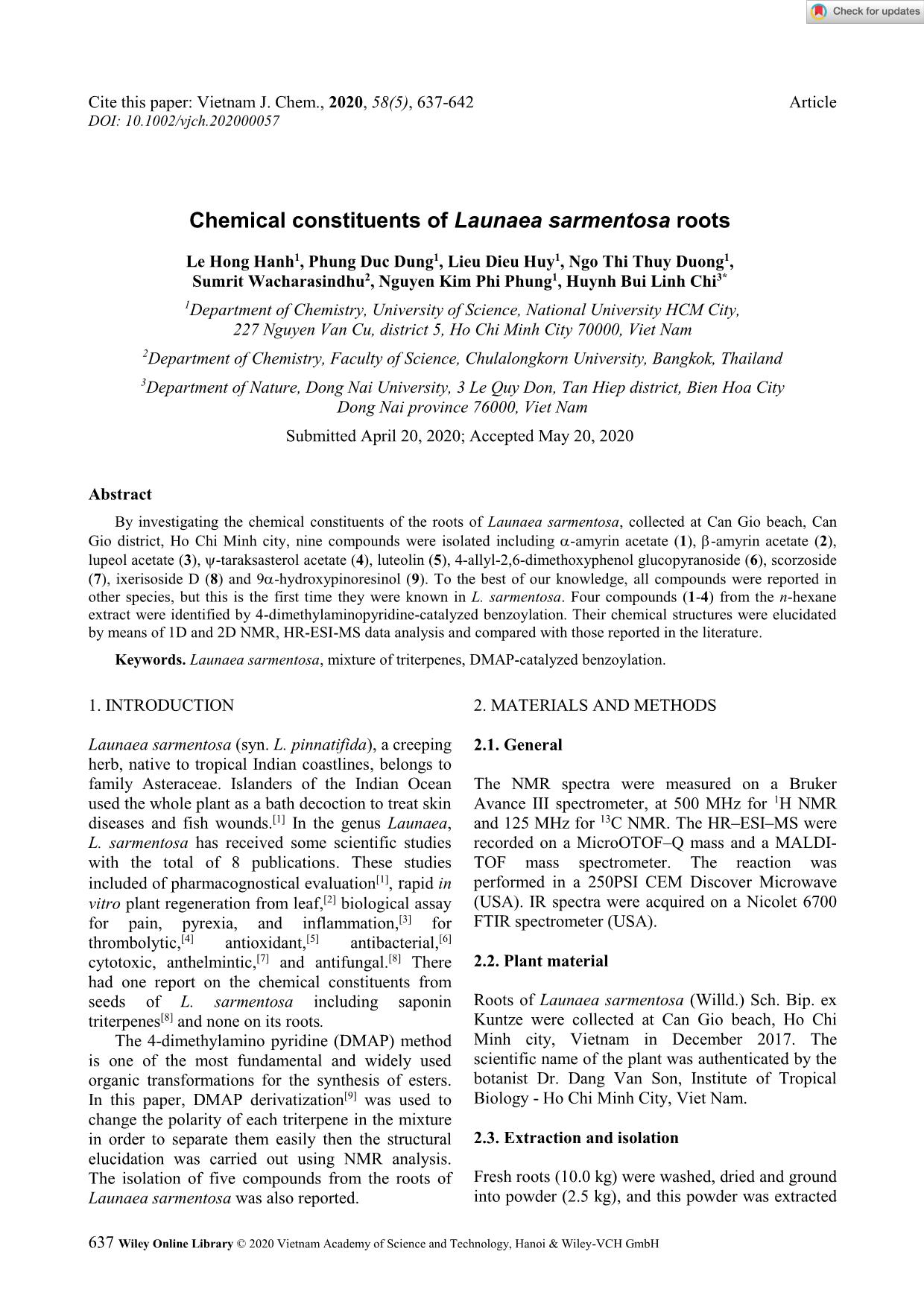
Trang 1
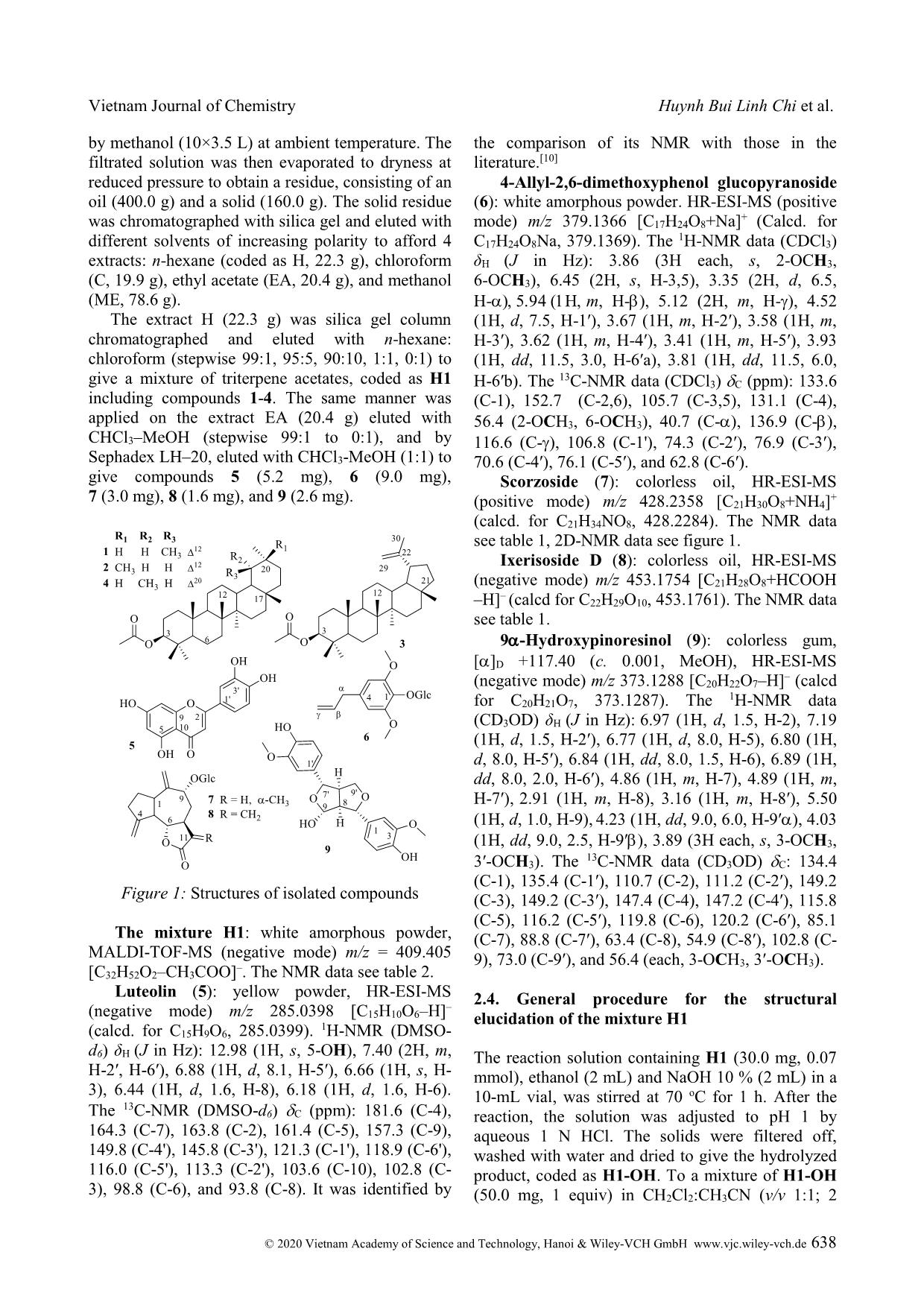
Trang 2
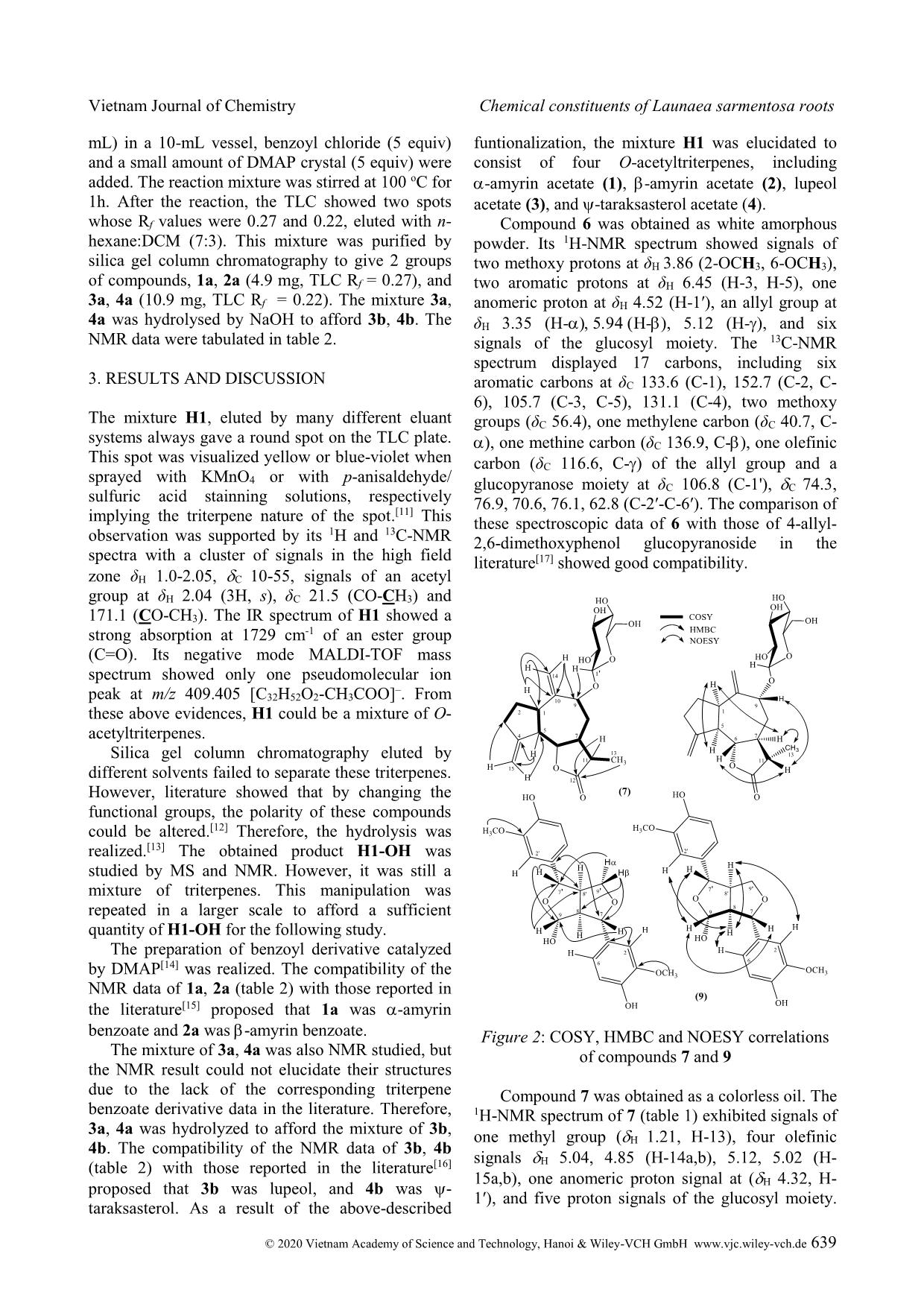
Trang 3
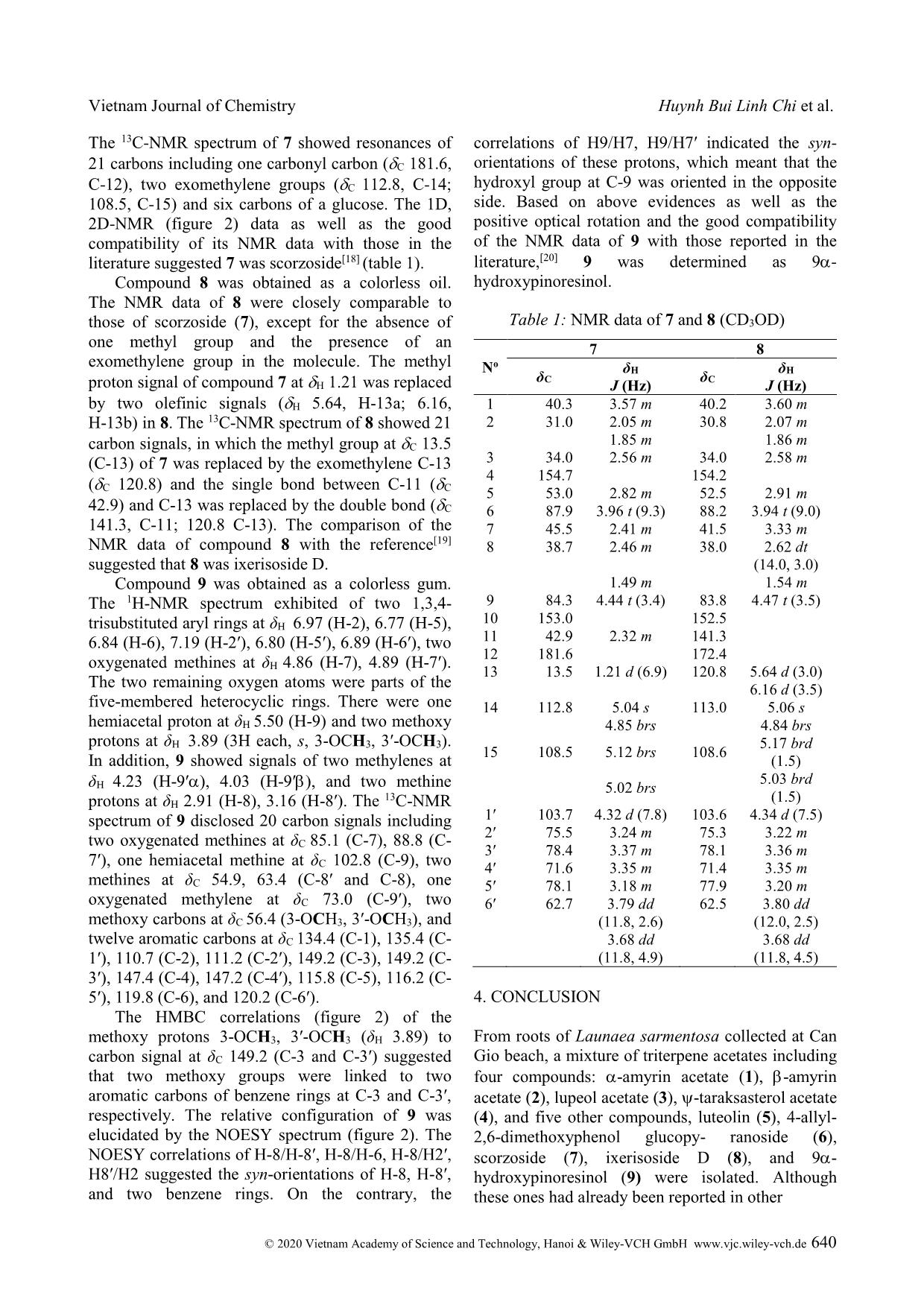
Trang 4
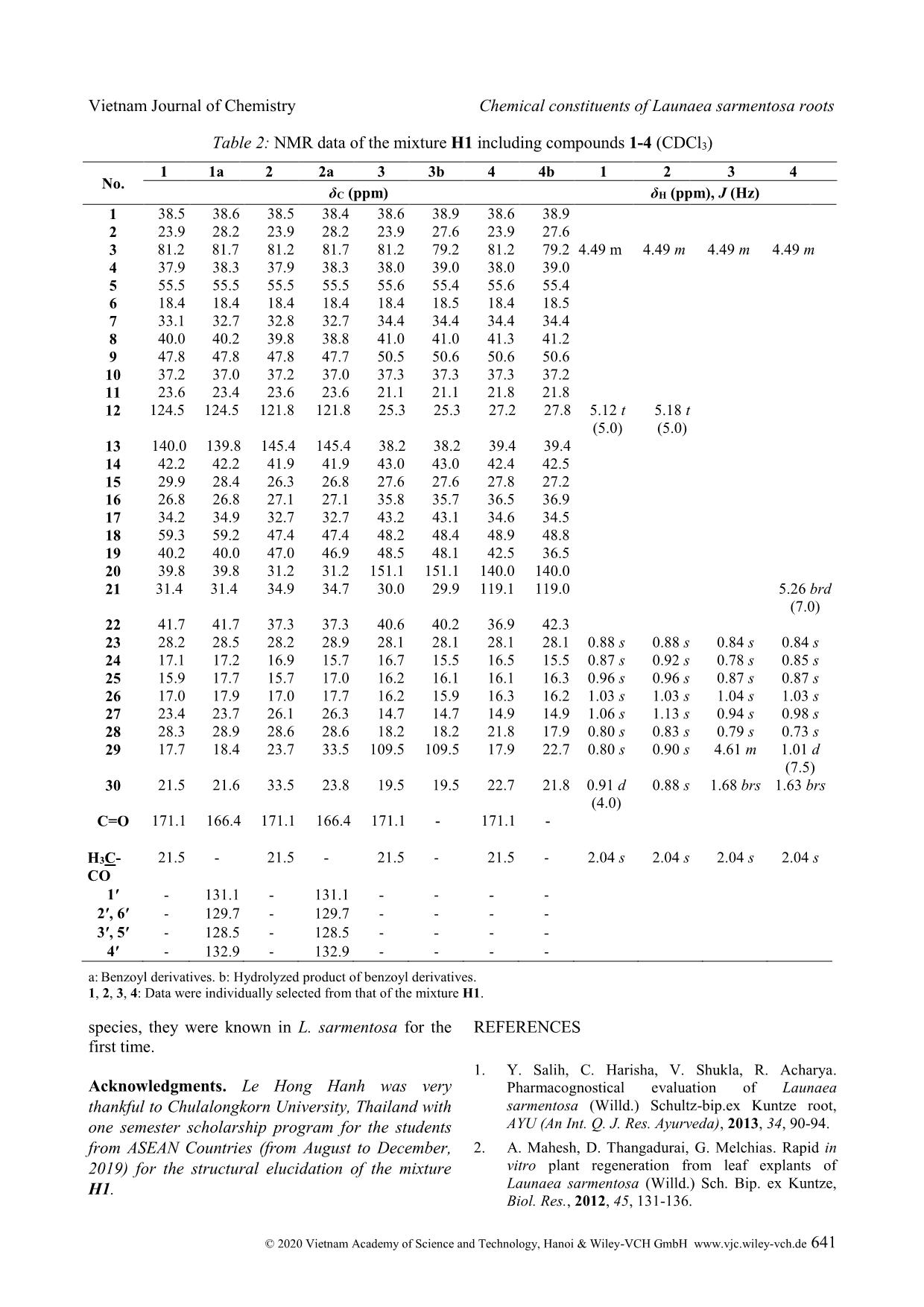
Trang 5
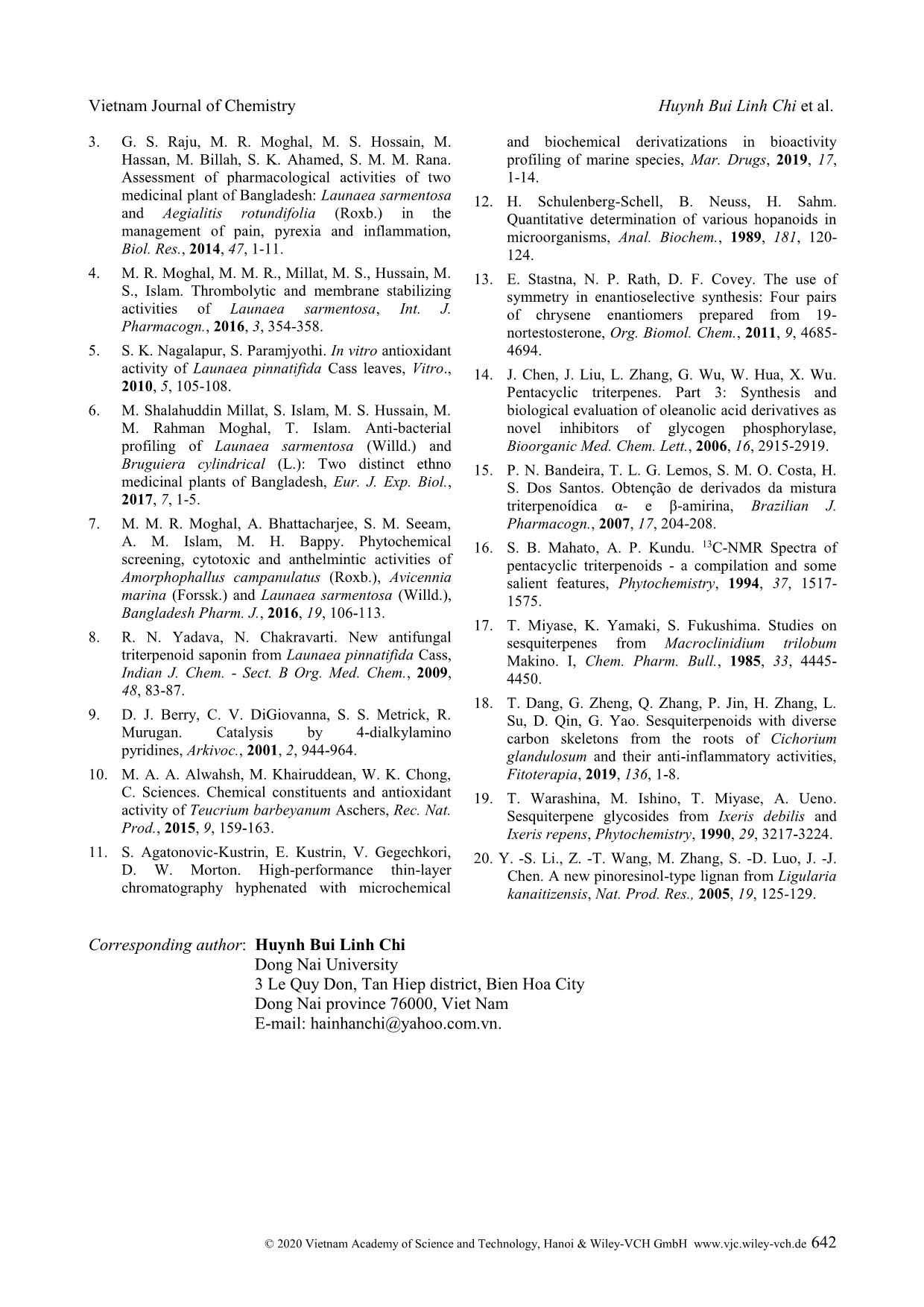
Trang 6
Tóm tắt nội dung tài liệu: Chemical constituents of Launaea sarmentosa roots
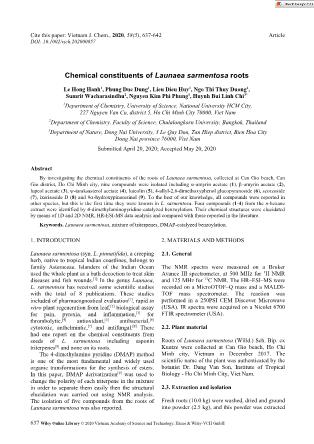
Cite this paper: Vietnam J. Chem., 2020, 58(5), 637-642 Article DOI: 10.1002/vjch.202000057 637 Wiley Online Library © 2020 Vietnam Academy of Science and Technology, Hanoi & Wiley-VCH GmbH Chemical constituents of Launaea sarmentosa roots Le Hong Hanh1, Phung Duc Dung1, Lieu Dieu Huy1, Ngo Thi Thuy Duong1, Sumrit Wacharasindhu2, Nguyen Kim Phi Phung1, Huynh Bui Linh Chi3* 1Department of Chemistry, University of Science, National University HCM City, 227 Nguyen Van Cu, district 5, Ho Chi Minh City 70000, Viet Nam 2Department of Chemistry, Faculty of Science, Chulalongkorn University, Bangkok, Thailand 3Department of Nature, Dong Nai University, 3 Le Quy Don, Tan Hiep district, Bien Hoa City Dong Nai province 76000, Viet Nam Submitted April 20, 2020; Accepted May 20, 2020 Abstract By investigating the chemical constituents of the roots of Launaea sarmentosa, collected at Can Gio beach, Can Gio district, Ho Chi Minh city, nine compounds were isolated including -amyrin acetate (1), -amyrin acetate (2), lupeol acetate (3), -taraksasterol acetate (4), luteolin (5), 4-allyl-2,6-dimethoxyphenol glucopyranoside (6), scorzoside (7), ixerisoside D (8) and 9 -hydroxypinoresinol (9). To the best of our knowledge, all compounds were reported in other species, but this is the first time they were known in L. sarmentosa. Four compounds (1-4) from the n-hexane extract were identified by 4-dimethylaminopyridine-catalyzed benzoylation. Their chemical structures were elucidated by means of 1D and 2D NMR, HR-ESI-MS data analysis and compared with those reported in the literature. Keywords. Launaea sarmentosa, mixture of triterpenes, DMAP-catalyzed benzoylation. 1. INTRODUCTION Launaea sarmentosa (syn. L. pinnatifida), a creeping herb, native to tropical Indian coastlines, belongs to family Asteraceae. Islanders of the Indian Ocean used the whole plant as a bath decoction to treat skin diseases and fish wounds.[1] In the genus Launaea, L. sarmentosa has received some scientific studies with the total of 8 publications. These studies included of pharmacognostical evaluation[1], rapid in vitro plant regeneration from leaf,[2] biological assay for pain, pyrexia, and inflammation,[3] for thrombolytic,[4] antioxidant,[5] antibacterial,[6] cytotoxic, anthelmintic,[7] and antifungal.[8] There had one report on the chemical constituents from seeds of L. sarmentosa including saponin triterpenes[8] and none on its roots. The 4-dimethylamino pyridine (DMAP) method is one of the most fundamental and widely used organic transformations for the synthesis of esters. In this paper, DMAP derivatization[9] was used to change the polarity of each triterpene in the mixture in order to separate them easily then the structural elucidation was carried out using NMR analysis. The isolation of five compounds from the roots of Launaea sarmentosa was also reported. 2. MATERIALS AND METHODS 2.1. General The NMR spectra were measured on a Bruker Avance III spectrometer, at 500 MHz for 1H NMR and 125 MHz for 13C NMR. The HR–ESI–MS were recorded on a MicroOTOF–Q mass and a MALDI- TOF mass spectrometer. The reaction was performed in a 250PSI CEM Discover Microwave (USA). IR spectra were acquired on a Nicolet 6700 FTIR spectrometer (USA). 2.2. Plant material Roots of Launaea sarmentosa (Willd.) Sch. Bip. ex Kuntze were collected at Can Gio beach, Ho Chi Minh city, Vietnam in December 2017. The scientific name of the plant was authenticated by the botanist Dr. Dang Van Son, Institute of Tropical Biology - Ho Chi Minh City, Viet Nam. 2.3. Extraction and isolation Fresh roots (10.0 kg) were washed, dried and ground into powder (2.5 kg), and this powder was extracted Vietnam Journal of Chemistry Huynh Bui Linh Chi et al. © 2020 Vietnam Academy of Science and Technology, Hanoi & Wiley-VCH GmbH www.vjc.wiley-vch.de 638 by methanol (10×3.5 L) at ambient temperature. The filtrated solution was then evaporated to dryness at reduced pressure to obtain a residue, consisting of an oil (400.0 g) and a solid (160.0 g). The solid residue was chromatographed with silica gel and eluted with different solvents of increasing polarity to afford 4 extracts: n-hexane (coded as H, 22.3 g), chloroform (C, 19.9 g), ethyl acetate (EA, 20.4 g), and methanol (ME, 78.6 g). The extract H (22.3 g) was silica gel column chromatographed and eluted with n-hexane: chloroform (stepwise 99:1, 95:5, 90:10, 1:1, 0:1) to give a mixture of triterpene acetates, coded as H1 including compounds 1-4. The same manner was applied on the extract EA (20.4 g) eluted with CHCl3–MeOH (stepwise 99:1 to 0:1), and by Sephadex LH–20, eluted with CHCl3-MeOH (1:1) to give compounds 5 (5.2 mg), 6 (9.0 mg), 7 (3.0 mg), 8 (1.6 mg), and 9 (2.6 mg). Figure 1: Structures of isolated compounds The mixture H1: white amorphous powder, MALDI-TOF-MS (negative mode) m/z = 409.405 [C32H52O2–CH3COO]–. The NMR data see table 2. Luteolin (5): yellow powder, HR-ESI-MS (negative mode) m/z 285.0398 [C15H10O6–H]– (calcd. for C15H9O6, 285.0399). 1H-NMR (DMSO- d6) δH (J in Hz): 12.98 (1H, s, 5-OH), 7.40 (2H, m, H-2′, H-6′), 6.88 (1H, d, 8.1, H-5′), 6.66 (1H, s, H- 3), 6.44 (1H, d, 1.6, H-8), 6.18 (1H, d, 1.6, H-6). The 13C-NMR (DMSO-d6) C (ppm): 181.6 (C-4), 164.3 (C-7), 163.8 (C-2), 161.4 (C-5), 157.3 (C-9), 149.8 (C-4'), 145.8 (C-3'), 121.3 (C-1'), 118.9 (C-6'), 116.0 (C-5'), 113.3 (C-2'), 103.6 (C-10), 102.8 (C- 3), 98.8 (C-6), and 93.8 (C-8). It was identified by the comparison of its NMR with those in the literature.[10] 4-Allyl-2,6-dimethoxyphenol glucopyranoside (6): white amorphous powder. HR-ESI-MS (positive mode) m/z 379.1366 [C17H24O8+Na]+ (Calcd. for C17H24O8Na, 379.1369). The 1H-NMR data (CDCl3) δH (J in Hz): 3.86 (3H each, s, 2-OCH3, 6-OCH3), 6.45 (2H, s, H-3,5), 3.35 (2H, d, 6.5, H- ... in a larger scale to afford a sufficient quantity of H1-OH for the following study. The preparation of benzoyl derivative catalyzed by DMAP[14] was realized. The compatibility of the NMR data of 1a, 2a (table 2) with those reported in the literature[15] proposed that 1a was -amyrin benzoate and 2a was -amyrin benzoate. The mixture of 3a, 4a was also NMR studied, but the NMR result could not elucidate their structures due to the lack of the corresponding triterpene benzoate derivative data in the literature. Therefore, 3a, 4a was hydrolyzed to afford the mixture of 3b, 4b. The compatibility of the NMR data of 3b, 4b (table 2) with those reported in the literature[16] proposed that 3b was lupeol, and 4b was - taraksasterol. As a result of the above-described funtionalization, the mixture H1 was elucidated to consist of four O-acetyltriterpenes, including -amyrin acetate (1), -amyrin acetate (2), lupeol acetate (3), and -taraksasterol acetate (4). Compound 6 was obtained as white amorphous powder. Its 1H-NMR spectrum showed signals of two methoxy protons at δH 3.86 (2-OCH3, 6-OCH3), two aromatic protons at δH 6.45 (H-3, H-5), one anomeric proton at δH 4.52 (H-1′), an allyl group at δH 3.35 (H- H-), 5.12 (H-), and six signals of the glucosyl moiety. The 13C-NMR spectrum displayed 17 carbons, including six aromatic carbons at δC 133.6 (C-1), 152.7 (C-2, C- 6), 105.7 (C-3, C-5), 131.1 (C-4), two methoxy groups (δC 56.4), one methylene carbon (δC 40.7, C- ), one methine carbon (δC 136.9, C-), one olefinic carbon (δC 116.6, C-) of the allyl group and a glucopyranose moiety at δC 106.8 (C-1'), C 74.3, 76.9, 70.6, 76.1, 62.8 (C-2′-C-6′). The comparison of these spectroscopic data of 6 with those of 4-allyl- 2,6-dimethoxyphenol glucopyranoside in the literature[17] showed good compatibility. Figure 2: COSY, HMBC and NOESY correlations of compounds 7 and 9 Compound 7 was obtained as a colorless oil. The 1H-NMR spectrum of 7 (table 1) exhibited signals of one methyl group (H 1.21, H-13), four olefinic signals H 5.04, 4.85 (H-14a,b), 5.12, 5.02 (H- 15a,b), one anomeric proton signal at (H 4.32, H- 1′), and five proton signals of the glucosyl moiety. Vietnam Journal of Chemistry Huynh Bui Linh Chi et al. © 2020 Vietnam Academy of Science and Technology, Hanoi & Wiley-VCH GmbH www.vjc.wiley-vch.de 640 The 13C-NMR spectrum of 7 showed resonances of 21 carbons including one carbonyl carbon (C 181.6, C-12), two exomethylene groups (C 112.8, C-14; 108.5, C-15) and six carbons of a glucose. The 1D, 2D-NMR (figure 2) data as well as the good compatibility of its NMR data with those in the literature suggested 7 was scorzoside[18] (table 1). Compound 8 was obtained as a colorless oil. The NMR data of 8 were closely comparable to those of scorzoside (7), except for the absence of one methyl group and the presence of an exomethylene group in the molecule. The methyl proton signal of compound 7 at H 1.21 was replaced by two olefinic signals (H 5.64, H-13a; 6.16, H-13b) in 8. The 13C-NMR spectrum of 8 showed 21 carbon signals, in which the methyl group at C 13.5 (C-13) of 7 was replaced by the exomethylene C-13 (C 120.8) and the single bond between C-11 (C 42.9) and C-13 was replaced by the double bond (C 141.3, C-11; 120.8 C-13). The comparison of the NMR data of compound 8 with the reference[19] suggested that 8 was ixerisoside D. Compound 9 was obtained as a colorless gum. The 1H-NMR spectrum exhibited of two 1,3,4- trisubstituted aryl rings at δH 6.97 (H-2), 6.77 (H-5), 6.84 (H-6), 7.19 (H-2′), 6.80 (H-5′), 6.89 (H-6′), two oxygenated methines at δH 4.86 (H-7), 4.89 (H-7′). The two remaining oxygen atoms were parts of the five-membered heterocyclic rings. There were one hemiacetal proton at δH 5.50 (H-9) and two methoxy protons at δH 3.89 (3H each, s, 3-OCH3, 3′-OCH3). In addition, 9 showed signals of two methylenes at δH 4.23 (H-9′ ), 4.03 (H-9′), and two methine protons at δH 2.91 (H-8), 3.16 (H-8′). The 13C-NMR spectrum of 9 disclosed 20 carbon signals including two oxygenated methines at δC 85.1 (C-7), 88.8 (C- 7′), one hemiacetal methine at δC 102.8 (C-9), two methines at δC 54.9, 63.4 (C-8′ and C-8), one oxygenated methylene at δC 73.0 (C-9′), two methoxy carbons at δC 56.4 (3-OCH3, 3′-OCH3), and twelve aromatic carbons at δC 134.4 (C-1), 135.4 (C- 1′), 110.7 (C-2), 111.2 (C-2′), 149.2 (C-3), 149.2 (C- 3′), 147.4 (C-4), 147.2 (C-4′), 115.8 (C-5), 116.2 (C- 5′), 119.8 (C-6), and 120.2 (C-6′). The HMBC correlations (figure 2) of the methoxy protons 3-OCH3, 3′-OCH3 (δH 3.89) to carbon signal at δC 149.2 (C-3 and C-3′) suggested that two methoxy groups were linked to two aromatic carbons of benzene rings at C-3 and C-3′, respectively. The relative configuration of 9 was elucidated by the NOESY spectrum (figure 2). The NOESY correlations of H-8/H-8′, H-8/H-6, H-8/H2′, H8′/H2 suggested the syn-orientations of H-8, H-8′, and two benzene rings. On the contrary, the correlations of H9/H7, H9/H7′ indicated the syn- orientations of these protons, which meant that the hydroxyl group at C-9 was oriented in the opposite side. Based on above evidences as well as the positive optical rotation and the good compatibility of the NMR data of 9 with those reported in the literature,[20] 9 was determined as 9 - hydroxypinoresinol. Table 1: NMR data of 7 and 8 (CD3OD) No 7 8 δC δH J (Hz) δC δH J (Hz) 1 40.3 3.57 m 40.2 3.60 m 2 31.0 2.05 m 30.8 2.07 m 1.85 m 1.86 m 3 34.0 2.56 m 34.0 2.58 m 4 154.7 154.2 5 53.0 2.82 m 52.5 2.91 m 6 87.9 3.96 t (9.3) 88.2 3.94 t (9.0) 7 45.5 2.41 m 41.5 3.33 m 8 38.7 2.46 m 38.0 2.62 dt (14.0, 3.0) 1.49 m 1.54 m 9 84.3 4.44 t (3.4) 83.8 4.47 t (3.5) 10 153.0 152.5 11 42.9 2.32 m 141.3 12 181.6 172.4 13 13.5 1.21 d (6.9) 120.8 5.64 d (3.0) 6.16 d (3.5) 14 112.8 5.04 s 113.0 5.06 s 4.85 brs 4.84 brs 15 108.5 5.12 brs 108.6 5.17 brd (1.5) 5.02 brs 5.03 brd (1.5) 1′ 103.7 4.32 d (7.8) 103.6 4.34 d (7.5) 2′ 75.5 3.24 m 75.3 3.22 m 3′ 78.4 3.37 m 78.1 3.36 m 4′ 71.6 3.35 m 71.4 3.35 m 5′ 78.1 3.18 m 77.9 3.20 m 6′ 62.7 3.79 dd (11.8, 2.6) 62.5 3.80 dd (12.0, 2.5) 3.68 dd (11.8, 4.9) 3.68 dd (11.8, 4.5) 4. CONCLUSION From roots of Launaea sarmentosa collected at Can Gio beach, a mixture of triterpene acetates including four compounds: -amyrin acetate (1), -amyrin acetate (2), lupeol acetate (3), -taraksasterol acetate (4), and five other compounds, luteolin (5), 4-allyl- 2,6-dimethoxyphenol glucopy- ranoside (6), scorzoside (7), ixerisoside D (8), and 9 - hydroxypinoresinol (9) were isolated. Although these ones had already been reported in other Vietnam Journal of Chemistry Chemical constituents of Launaea sarmentosa roots © 2020 Vietnam Academy of Science and Technology, Hanoi & Wiley-VCH GmbH www.vjc.wiley-vch.de 641 Table 2: NMR data of the mixture H1 including compounds 1-4 (CDCl3) No. 1 1a 2 2a 3 3b 4 4b 1 2 3 4 δC (ppm) δH (ppm), J (Hz) 1 38.5 38.6 38.5 38.4 38.6 38.9 38.6 38.9 2 23.9 28.2 23.9 28.2 23.9 27.6 23.9 27.6 3 81.2 81.7 81.2 81.7 81.2 79.2 81.2 79.2 4.49 m 4.49 m 4.49 m 4.49 m 4 37.9 38.3 37.9 38.3 38.0 39.0 38.0 39.0 5 55.5 55.5 55.5 55.5 55.6 55.4 55.6 55.4 6 18.4 18.4 18.4 18.4 18.4 18.5 18.4 18.5 7 33.1 32.7 32.8 32.7 34.4 34.4 34.4 34.4 8 40.0 40.2 39.8 38.8 41.0 41.0 41.3 41.2 9 47.8 47.8 47.8 47.7 50.5 50.6 50.6 50.6 10 37.2 37.0 37.2 37.0 37.3 37.3 37.3 37.2 11 23.6 23.4 23.6 23.6 21.1 21.1 21.8 21.8 12 124.5 124.5 121.8 121.8 25.3 25.3 27.2 27.8 5.12 t (5.0) 5.18 t (5.0) 13 140.0 139.8 145.4 145.4 38.2 38.2 39.4 39.4 14 42.2 42.2 41.9 41.9 43.0 43.0 42.4 42.5 15 29.9 28.4 26.3 26.8 27.6 27.6 27.8 27.2 16 26.8 26.8 27.1 27.1 35.8 35.7 36.5 36.9 17 34.2 34.9 32.7 32.7 43.2 43.1 34.6 34.5 18 59.3 59.2 47.4 47.4 48.2 48.4 48.9 48.8 19 40.2 40.0 47.0 46.9 48.5 48.1 42.5 36.5 20 39.8 39.8 31.2 31.2 151.1 151.1 140.0 140.0 21 31.4 31.4 34.9 34.7 30.0 29.9 119.1 119.0 5.26 brd (7.0) 22 41.7 41.7 37.3 37.3 40.6 40.2 36.9 42.3 23 28.2 28.5 28.2 28.9 28.1 28.1 28.1 28.1 0.88 s 0.88 s 0.84 s 0.84 s 24 17.1 17.2 16.9 15.7 16.7 15.5 16.5 15.5 0.87 s 0.92 s 0.78 s 0.85 s 25 15.9 17.7 15.7 17.0 16.2 16.1 16.1 16.3 0.96 s 0.96 s 0.87 s 0.87 s 26 17.0 17.9 17.0 17.7 16.2 15.9 16.3 16.2 1.03 s 1.03 s 1.04 s 1.03 s 27 23.4 23.7 26.1 26.3 14.7 14.7 14.9 14.9 1.06 s 1.13 s 0.94 s 0.98 s 28 28.3 28.9 28.6 28.6 18.2 18.2 21.8 17.9 0.80 s 0.83 s 0.79 s 0.73 s 29 17.7 18.4 23.7 33.5 109.5 109.5 17.9 22.7 0.80 s 0.90 s 4.61 m 1.01 d (7.5) 30 21.5 21.6 33.5 23.8 19.5 19.5 22.7 21.8 0.91 d (4.0) 0.88 s 1.68 brs 1.63 brs C=O 171.1 166.4 171.1 166.4 171.1 - 171.1 - H3C- CO 21.5 - 21.5 - 21.5 - 21.5 - 2.04 s 2.04 s 2.04 s 2.04 s 1′ - 131.1 - 131.1 - - - - 2′, 6′ - 129.7 - 129.7 - - - - 3′, 5′ - 128.5 - 128.5 - - - - 4′ - 132.9 - 132.9 - - - - a: Benzoyl derivatives. b: Hydrolyzed product of benzoyl derivatives. 1, 2, 3, 4: Data were individually selected from that of the mixture H1. species, they were known in L. sarmentosa for the first time. Acknowledgments. Le Hong Hanh was very thankful to Chulalongkorn University, Thailand with one semester scholarship program for the students from ASEAN Countries (from August to December, 2019) for the structural elucidation of the mixture H1. REFERENCES 1. Y. Salih, C. Harisha, V. Shukla, R. Acharya. Pharmacognostical evaluation of Launaea sarmentosa (Willd.) Schultz-bip.ex Kuntze root, AYU (An Int. Q. J. Res. Ayurveda), 2013, 34, 90-94. 2. A. Mahesh, D. Thangadurai, G. Melchias. Rapid in vitro plant regeneration from leaf explants of Launaea sarmentosa (Willd.) Sch. Bip. ex Kuntze, Biol. Res., 2012, 45, 131-136. Vietnam Journal of Chemistry Huynh Bui Linh Chi et al. © 2020 Vietnam Academy of Science and Technology, Hanoi & Wiley-VCH GmbH www.vjc.wiley-vch.de 642 3. G. S. Raju, M. R. Moghal, M. S. Hossain, M. Hassan, M. Billah, S. K. Ahamed, S. M. M. Rana. Assessment of pharmacological activities of two medicinal plant of Bangladesh: Launaea sarmentosa and Aegialitis rotundifolia (Roxb.) in the management of pain, pyrexia and inflammation, Biol. Res., 2014, 47, 1-11. 4. M. R. Moghal, M. M. R., Millat, M. S., Hussain, M. S., Islam. Thrombolytic and membrane stabilizing activities of Launaea sarmentosa, Int. J. Pharmacogn., 2016, 3, 354-358. 5. S. K. Nagalapur, S. Paramjyothi. In vitro antioxidant activity of Launaea pinnatifida Cass leaves, Vitro., 2010, 5, 105-108. 6. M. Shalahuddin Millat, S. Islam, M. S. Hussain, M. M. Rahman Moghal, T. Islam. Anti-bacterial profiling of Launaea sarmentosa (Willd.) and Bruguiera cylindrical (L.): Two distinct ethno medicinal plants of Bangladesh, Eur. J. Exp. Biol., 2017, 7, 1-5. 7. M. M. R. Moghal, A. Bhattacharjee, S. M. Seeam, A. M. Islam, M. H. Bappy. Phytochemical screening, cytotoxic and anthelmintic activities of Amorphophallus campanulatus (Roxb.), Avicennia marina (Forssk.) and Launaea sarmentosa (Willd.), Bangladesh Pharm. J., 2016, 19, 106-113. 8. R. N. Yadava, N. Chakravarti. New antifungal triterpenoid saponin from Launaea pinnatifida Cass, Indian J. Chem. - Sect. B Org. Med. Chem., 2009, 48, 83-87. 9. D. J. Berry, C. V. DiGiovanna, S. S. Metrick, R. Murugan. Catalysis by 4-dialkylamino pyridines, Arkivoc., 2001, 2, 944-964. 10. M. A. A. Alwahsh, M. Khairuddean, W. K. Chong, C. Sciences. Chemical constituents and antioxidant activity of Teucrium barbeyanum Aschers, Rec. Nat. Prod., 2015, 9, 159-163. 11. S. Agatonovic-Kustrin, E. Kustrin, V. Gegechkori, D. W. Morton. High-performance thin-layer chromatography hyphenated with microchemical and biochemical derivatizations in bioactivity profiling of marine species, Mar. Drugs, 2019, 17, 1-14. 12. H. Schulenberg-Schell, B. Neuss, H. Sahm. Quantitative determination of various hopanoids in microorganisms, Anal. Biochem., 1989, 181, 120- 124. 13. E. Stastna, N. P. Rath, D. F. Covey. The use of symmetry in enantioselective synthesis: Four pairs of chrysene enantiomers prepared from 19- nortestosterone, Org. Biomol. Chem., 2011, 9, 4685- 4694. 14. J. Chen, J. Liu, L. Zhang, G. Wu, W. Hua, X. Wu. Pentacyclic triterpenes. Part 3: Synthesis and biological evaluation of oleanolic acid derivatives as novel inhibitors of glycogen phosphorylase, Bioorganic Med. Chem. Lett., 2006, 16, 2915-2919. 15. P. N. Bandeira, T. L. G. Lemos, S. M. O. Costa, H. S. Dos Santos. Obtenção de derivados da mistura triterpenoídica α- e β-amirina, Brazilian J. Pharmacogn., 2007, 17, 204-208. 16. S. B. Mahato, A. P. Kundu. 13C-NMR Spectra of pentacyclic triterpenoids - a compilation and some salient features, Phytochemistry, 1994, 37, 1517- 1575. 17. T. Miyase, K. Yamaki, S. Fukushima. Studies on sesquiterpenes from Macroclinidium trilobum Makino. I, Chem. Pharm. Bull., 1985, 33, 4445- 4450. 18. T. Dang, G. Zheng, Q. Zhang, P. Jin, H. Zhang, L. Su, D. Qin, G. Yao. Sesquiterpenoids with diverse carbon skeletons from the roots of Cichorium glandulosum and their anti-inflammatory activities, Fitoterapia, 2019, 136, 1-8. 19. T. Warashina, M. Ishino, T. Miyase, A. Ueno. Sesquiterpene glycosides from Ixeris debilis and Ixeris repens, Phytochemistry, 1990, 29, 3217-3224. 20. Y. -S. Li., Z. -T. Wang, M. Zhang, S. -D. Luo, J. -J. Chen. A new pinoresinol-type lignan from Ligularia kanaitizensis, Nat. Prod. Res., 2005, 19, 125-129. Corresponding author: Huynh Bui Linh Chi Dong Nai University 3 Le Quy Don, Tan Hiep district, Bien Hoa City Dong Nai province 76000, Viet Nam E-mail: hainhanchi@yahoo.com.vn.
File đính kèm:
 chemical_constituents_of_launaea_sarmentosa_roots.pdf
chemical_constituents_of_launaea_sarmentosa_roots.pdf

